High Rock, Low Rock, and Other Miscellany
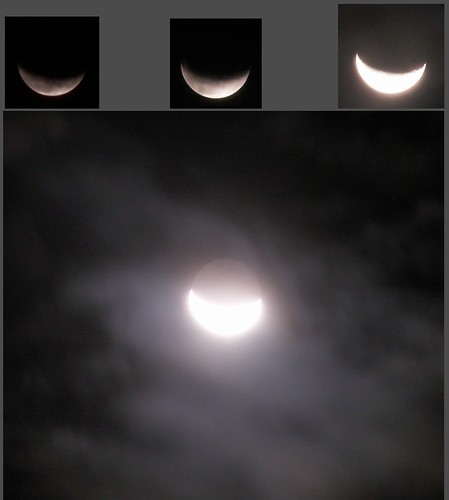
Click here for the large view.
Sunday night Mary and I watched Game 4 of the NLCS, which made me happy because I grew up in Brooklyn and am a Mets fan (when I'm not a Red Sox fan). Granted,my Mets are the 1973 team, from the days of Tom Seaver, Tug "The Fireman" McGraw, Ed Kranepool, Bud Harrelson, Willie Mays, and a bunch of folks I don't remember. My mother was recovering from her first heart attack when they won the World Series in '69; hence I didn't pay attention until the year they won the pennant.
The connection the above photo has with baseball relates to a terrific moon shot Fox aired during Sunday night's game, around 9 PM as I recall. And I spluttered, "That moon's not up now! It won't rise until after midnight!"
I ran outside during the next set of commercials for confirmation. Then I checked the Old Farmer's Almanac. Sunday night, for our location, the moon didn't rise until 1:38 AM. There was no way that extraordinary shot was being taken during the game.
That didn't stop me from popping outside after 4:30 Monday morning and setting up my tripod....
The top right photo shows a hint of earthshine, while the full overexposure of the moon and clouds in the large image shows earthshine prominently. The moon was 28% of full and six days before New when I took the shots.
From left to right, all times EDT:
4:36 AM, 1/25-second exposure at f/4.5
4:39 AM, 1-second exposure at f/8
4:42 AM, 4-second exposure at f/8
I took the large bottom photo at 4:44 AM, a 4-second exposure at f/4.5
In earthshine, the moon reflects light from two different sources. The thin crescent is light reflected from the sun. But the larger, dimmer illumination, is reflected from the Earth, which itself is reflecting sunlight onto the moon. Hence the term "earthshine". That dimmer illuminated part of the moon is doubly-reflected light.
Says the University of Maryland Department of Astronomy, "Each time light reflects off a surface (like a planet), it gets dimmer because some of the light is absorbed by the reflecting surface. This means that earthshine is dimmer than moonlight because earthshine is sunlight that has been reflected twice and moonlight is sunlight that has been reflected only once (off the surface of the moon). In addition, the reflectivity of the moon (its 'albedo') is less than that of the Earth, which makes earthshine even dimmer. The moonlight of a full moon, for example, is so bright that, even if it were positioned correctly to reflect light back toward Earth, it would completely overpower earthshine."
The moon was also in conjunction with Saturn, but I saw only brief glimpses of the planet due to the cloud cover.
That took care of the high rock.
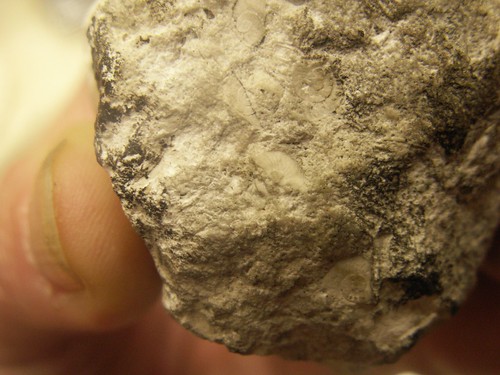
Click here for the large view.
This is another photographic angle of the same rock shown in close-ups in this entry. Just to the upper left (and still in shadow) of the spiral-shaped snail fossil near the bottom of the photo is where Mary thinks she sees a trilobite imprint. She was able to see two lobes and part of a third, and the "cross-hatching" marks shown on trilobite fossil photos.
When I told her, "I've never seen a trilobite image like that," she countered, "Well, they don't show you the duds!"
Trilobite fossils are found worldwide. They were water creatures and Florida is surrounded on three sides by water, ipso facto.
In my quest for trilobite info I found the Florida Museum of Natural History (FLMNH) and its call for volunteers to help out on a paleontological dig. I've always been curious about what it would be like to go on one of those. I loved dinosaurs as a kid (somewhere there's probably a kid who didn't, but I can't imagine who). Mary and I watch paleontology shows on channels like History and Discovery. I'd always thought I'd need to devote weeks out of my life and travel to far-off locales just to get a taste of it.
Surprise!
The dig site is only about 60 miles from where I live. Volunteers (no prior experience needed!) can come for a day (or just a shift within a day) so long as the day still has volunteer positions available -- and as of their October 10 list there are many days that still have room. Volunteers work alongside museum staff and University of Florida graduate students.
I signed up for November 8 and today received confirmation. I plan to sign up for more unless I decide the experience is not for me. But I suspect I'll love it.
This particular dig, the Tapir Challenge, goes through most of December and is geared toward tapir fossils. Tapirs, according to the museum, "are hoofed, plant-eating mammals distantly related to horses and rhinos." Modern tapirs exist, living in southern Central and South America and southeastern Asia; but their ancient cousins disappeared from Florida about 11,000 years ago. Says FLMNH, "More fossils of Tapirus have been found in Florida than any other region of the world."
The site has also yielded fossil bones and teeth of about 35 different kinds of freshwater and land animals. Frankly, I don't care what I'd be looking for. I don't care that the animal isn't a dinosaur or that it still exists somewhere in the modern world. The fossils at this particular site are from the Pliocene Epoch. If I found anything it would be an estimated two million years old. That thought alone thrills me. Heck, even seeing cycads on our "post office walks" thrills me, because those plants trace their ancestry directly back to the early Mesozoic era (Source: Floridata.com). In other words, 248 to 65 million years ago: the time of the dinosaurs.
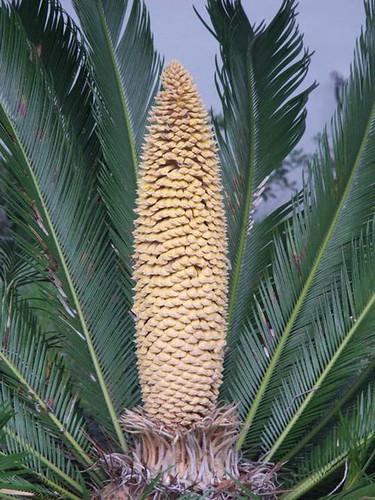
(Dioon edule, Family Zamiaceae (coontie family), photographed back in May.)
And then to have a dig site virtually in my own back yard! How cool is that?
Mary plans to stay home, more for health than for other reasons. She's not enamored of squatting in a limestone quarry under even a post-summer Florida sun. Hiking the Grand Canyon was different because even when no shade was available we were still moving. Water and electrolytes will be provided, but I'll have food and proper clothing on hand. My broad-brimmed hat -- the one I wore during our 20 miles of hiking to and from the bottom of the GC -- will stay on my head.
Part of the reason I was still up at 4:30 Monday morning had to do with the newsletter I edit for the Art Center. We're changing its format, so I was doing some creative fiddling. I also received some terrific graphics from one of our members, who's a designer.
I created some of my own as well, including one that accompanies my "Please bear with us" newsletter renovation message for our one-color publication.
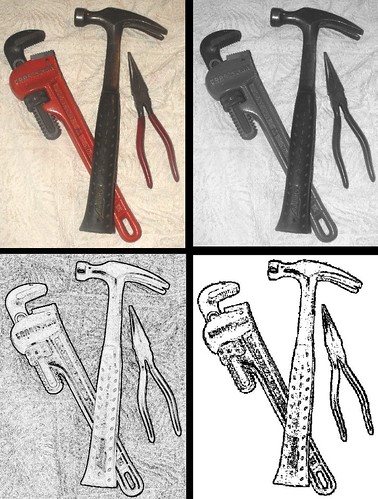
First I spread out a towel and borrowed a few of Mary's tools. I converted the original photo at upper left to black & white, then used MS Photo Editor's "Edge" function to produce the image at lower left. A few rounds of the "Transparency" function eliminated most but not all of the towel. I brought the image into MS Paint to clean up the image manually, then returned it to Photo Editor and increased the contrast.
After I finally went to bed and got in a decent sleep, I teamed with Mary to escort a Red-waisted Florella moth back outside.
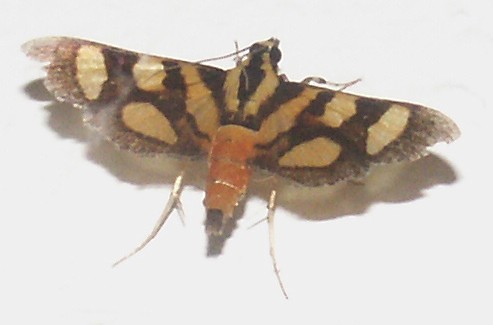
Almost a year ago I photographed this Syngamia florella on the outside wall of our house. This year the one above decided to hang out on our dining room wall just beneath the ceiling. I set up a series of crates, popped up the flash, and got this slightly different angle that includes its hind legs.
I couldn't get a ruler in place before it flew away but I'm guessing this one's wingspan is 15-20mm. Climbing on crates and then our dining table (otherwise known as our elevated horizontal filing system, not to be confused with our filing systems down on the floor), Mary managed to trap it inside a plastic container. Our guest loitered inside the container after I brought it onto the front porch, but took off as soon as I stuck my lens in to try to get a head shot.
This weekend is the annual convention of the Florida State Poets Association. In addition to producing the Art Center newsletter, I edit and produce the FSPA's annual poetry anthology, which I'll be distributing to folks who placed their orders. This year the convention is local to me and will be held a few blocks away from where I'll be teaching the final class of my creative writing course on Saturday. This week's schedule also includes writing meetings on Thursday and Friday along with freelance work.
I'm about halfway through the next-to-last scene of Book #4. After I finish the first draft I'll let that rest for a while -- and I'll rest for a while -- before I hunker down for the rewrite.











2 Comments:
I love the moon pics. I feel such a sisterhood with the moon. I wonder why that is.
Happy to be back!
The light is busting out of the moon container!
The dig sounds great. Digging for treasures. I used to dig for old bottles.
Post a Comment
<< Home